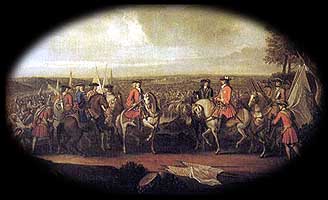 |
Blenheim
2004
Wargaming
the 300th Year Anniversary
Playing
the Big Game
photos
by David Mebust and Ian Croxall
|
|
|
 |
xxxxxxxxxxxxxxxxxxxxxxxxxxxxxxxxxxxxxxxxxxxxxxxxxxxxxxxxxxxxxxxxxxxxxx |
xxxxxxxxxxxxxxxxxxxxxxxxx |
|
|
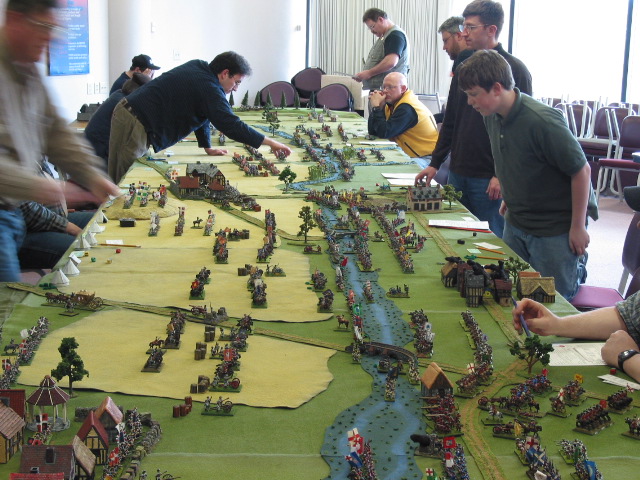 This
was our first attempt at the big game. The game was played on March 6 2004
in Eugene Oregon. We had 20 players each with two commands. The table was
36 ft by 6 ft and there are about 3,500 figures on the table. This
was our first attempt at the big game. The game was played on March 6 2004
in Eugene Oregon. We had 20 players each with two commands. The table was
36 ft by 6 ft and there are about 3,500 figures on the table.
This is a view from the Danube to the Barenberg
hills at the north western end of the 4 mile battlefield (hereafter referred
to as the North End). The camera is above the Danube (out of sight) at
the south east of the battlefield (hereafter referred to as the South End).
The village in the foreground left is Blindheim, Unterglau is on the right
and Oberglau is in the middle ground on the left.
|
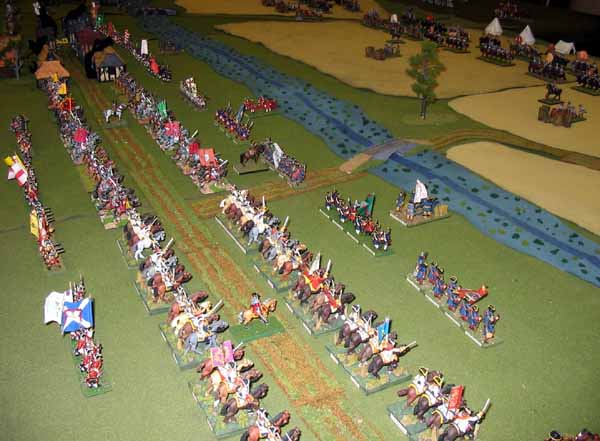 This
view, just south-east of center shows the allied center horse, with the
Danes in the fore ground, and the Hanoverian horse to their left. The allied
foot, with the Prussian regiments in Dutch service are deployed to their
front, and three English and one Scots battalions to their rear. In the
far ground on the allied side is the smoldering roofs of the village of
Unterglauheim. The allied battalion guns have been pushed up to the edge
of the Nebel and spend several hours in an artillery exchange with the
French guns while waiting for Eugene's army on the right wing to get into
place. This
view, just south-east of center shows the allied center horse, with the
Danes in the fore ground, and the Hanoverian horse to their left. The allied
foot, with the Prussian regiments in Dutch service are deployed to their
front, and three English and one Scots battalions to their rear. In the
far ground on the allied side is the smoldering roofs of the village of
Unterglauheim. The allied battalion guns have been pushed up to the edge
of the Nebel and spend several hours in an artillery exchange with the
French guns while waiting for Eugene's army on the right wing to get into
place.
Across the Nebel brook, the French center
horse can be seen at the edge of their camp.
|
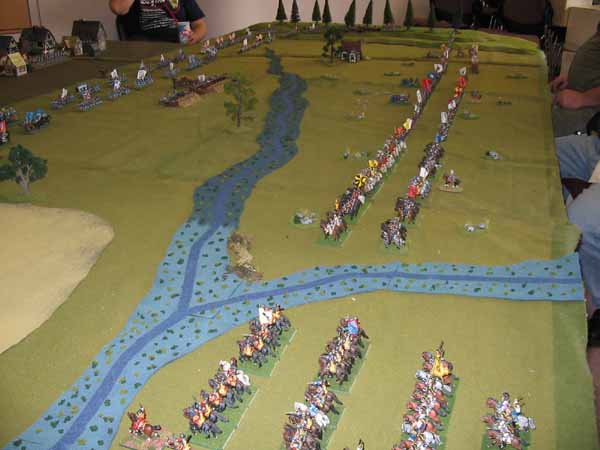 This
view from just north of Weilheim, the small fortified farm on the allied
center, shows the center of Eugene's cavalry on northwards. In eh distance
are the two lines of Prussian foot and in the extreme distance, the two
lines of Danish foot. This
view from just north of Weilheim, the small fortified farm on the allied
center, shows the center of Eugene's cavalry on northwards. In eh distance
are the two lines of Prussian foot and in the extreme distance, the two
lines of Danish foot.
In the middle of the Imperial horse are
two tributaries of the Nebel and beyond that the ground is broken and disrupting
for the troops.
Opposite the Prussian foot are the two
lines of Bavarian foot, with a third line behind them in the town of Lutzingen.
In front of the Bavarian foot can be made out the grand battery of Bavarian
guns.
|
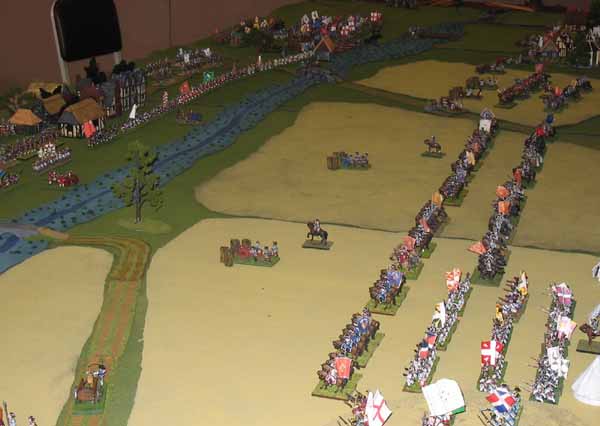 From
the French side, between Oberglauheim and Blindheim (seen here in the distance)
the open cornfields provide some excellent cavalry terrain. At the far
end of the line here, can be just made out the 8 squadrons of French Gendarmerie
- elite cavalry of the Sun Kings army. Behind them, out of sight are the
French reserve infantry who will later play an important role in the battle. From
the French side, between Oberglauheim and Blindheim (seen here in the distance)
the open cornfields provide some excellent cavalry terrain. At the far
end of the line here, can be just made out the 8 squadrons of French Gendarmerie
- elite cavalry of the Sun Kings army. Behind them, out of sight are the
French reserve infantry who will later play an important role in the battle.
In the rear line of the foreground is the
infantry division of Marquis de St. Pierre. Straddling the Hochstedt Muster
road is a 24lb battery of 4 guns, while light 3lb guns are spread across
the front of the cavalry.
In the very foreground can be seen the
tops of the standards of the Irish brigade on the Giessenberg Hill.
Lining the opposite banks of the Nebelbach
is a solid line if allied foot, with their cavalry massed behind them preparing
to cross. At the far end of the allied line can be seen Cutts' division
with his 20 battalions preparing to cross.
|
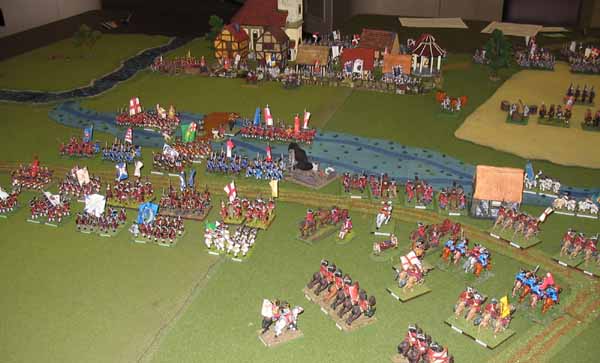 The
battle begins with several hours of artillery barrage while the Imperials
on the right flank brought into position. Then the main battle gets
under way with the lead brigade of Cutts' division crossing the Nebel.
They are met with fire from two batteries of 8lb guns deployed outside
of Blindheim village. The
battle begins with several hours of artillery barrage while the Imperials
on the right flank brought into position. Then the main battle gets
under way with the lead brigade of Cutts' division crossing the Nebel.
They are met with fire from two batteries of 8lb guns deployed outside
of Blindheim village.
As the English, Hanoverian and Hessian
foot of Cutts' division advance, the allied horse to their rear moves to
their right and also approach the Nebel.
Colonel Blood's artillery train is deployed
next to the Nebel between the two burned out mills and bombard the French
in the Village.
|
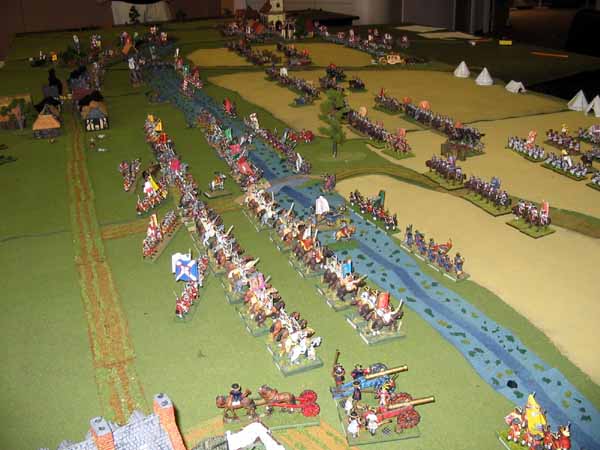 At
the same time, the allied front infantry line, Wurtemburg, Prussian, Ansbach
and Hanoverians all in Dutch and English pay scramble across the Nebel
and form up on the far bank, somewhat disordered. At
the same time, the allied front infantry line, Wurtemburg, Prussian, Ansbach
and Hanoverians all in Dutch and English pay scramble across the Nebel
and form up on the far bank, somewhat disordered.
However, the entire French cavalry line
advances to the bank to challenge the crossing. In the center (foreground)
the French learn the value of infantry firing lines and are devastated
by effective volleys and rolling platoon fire of the allied foot repel
much of the French center.
In the very foreground can be seen the
top of Weilheim farm, and the Hanoverian and Hessian guns (also from the
English artillery train) are deployed to fire on Oberglauheim. At the far
end of the French horse line, the Gendarmerie are met by Hanoverian horse
from Lt. General Bülow's Division.
During this period, Cutts' front brigade
is disrupted much more than expected on the south end of the battle and
their advance is slowed significantly.
|
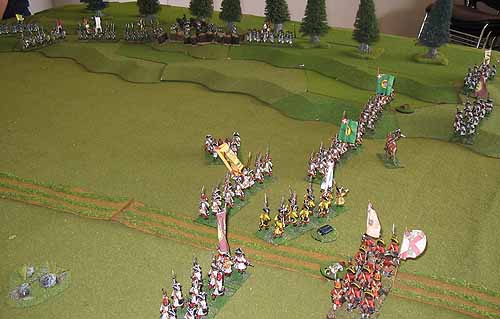 At
the same time on the extreme right end of the allied line, the Danes begin
their advance towards the French who are hooked around on the edge if the
hills in the wood line. The Danes avoid the French batteries in the woods
by staying to the left, whereupon the begin engaging the batteries, eventually
taking the battery but not making any significant ground against the foot. At
the same time on the extreme right end of the allied line, the Danes begin
their advance towards the French who are hooked around on the edge if the
hills in the wood line. The Danes avoid the French batteries in the woods
by staying to the left, whereupon the begin engaging the batteries, eventually
taking the battery but not making any significant ground against the foot.
(The one battalion of Irish seen in the
photograph is a temporary substitute for a Danish battalion that was not
completed in time for the battle).
|
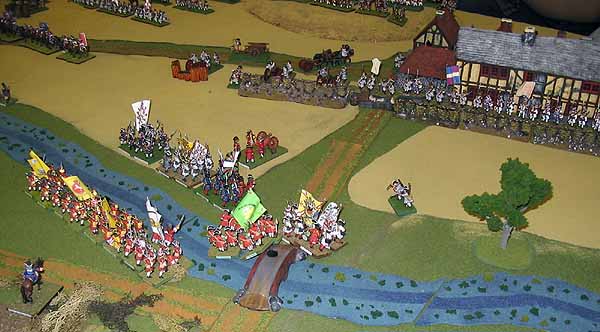 In
the Center, The Prince of Holstein Beck advances across the Nebel at the
head of Lt. General Horn's division to assault the village of Oberglauheim.
Here already, we can see that one of the battalions is falling behind causing
disruption in the line. Supporting the village are two batteries of French
heavy guns, several 24lbers and several of the new French three-barrelled
artillery pieces, which wreck havoc on the Dutch and Hanoverian Swiss battalions
of the front line. In
the Center, The Prince of Holstein Beck advances across the Nebel at the
head of Lt. General Horn's division to assault the village of Oberglauheim.
Here already, we can see that one of the battalions is falling behind causing
disruption in the line. Supporting the village are two batteries of French
heavy guns, several 24lbers and several of the new French three-barrelled
artillery pieces, which wreck havoc on the Dutch and Hanoverian Swiss battalions
of the front line. |
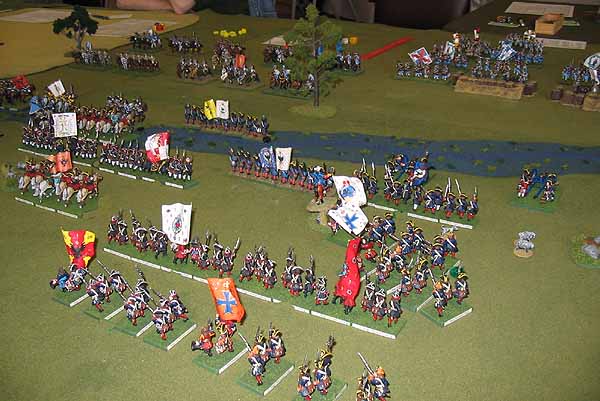 After
being deployed across the front of the Bavarians, the Prussian commander
was given orders to re concentrate to the left away from the guns. The
rather unhistorical move, to left face and leave a big hole in the line
resulted in the Prussians going nowhere and getting stuck and mixed up
with the horse to their left. After
being deployed across the front of the Bavarians, the Prussian commander
was given orders to re concentrate to the left away from the guns. The
rather unhistorical move, to left face and leave a big hole in the line
resulted in the Prussians going nowhere and getting stuck and mixed up
with the horse to their left.
At the same time, the Imperial horse to
the Prussian foot's right was met as it crossed the Nebel by the Bavarian
horse. At this time the whole front, with the exception of the Prussian
foot was engaged from the Danube to the foot hills.
|
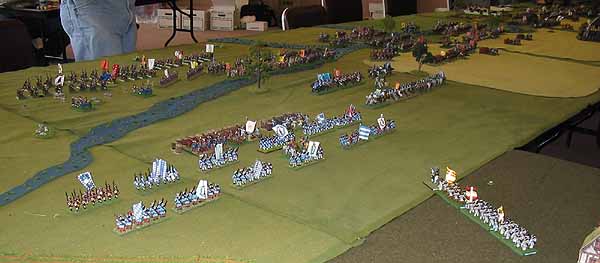 So
confident was the Bavarian commander now that the Prussians were no threat
to him, he withdrew his third line from Lutzingen and began tp move them
forward and to the left of the Bavarian front. So
confident was the Bavarian commander now that the Prussians were no threat
to him, he withdrew his third line from Lutzingen and began tp move them
forward and to the left of the Bavarian front.
After 5 game hours of battle, the Prussians
got but one or two battalions across the Nebel.
|
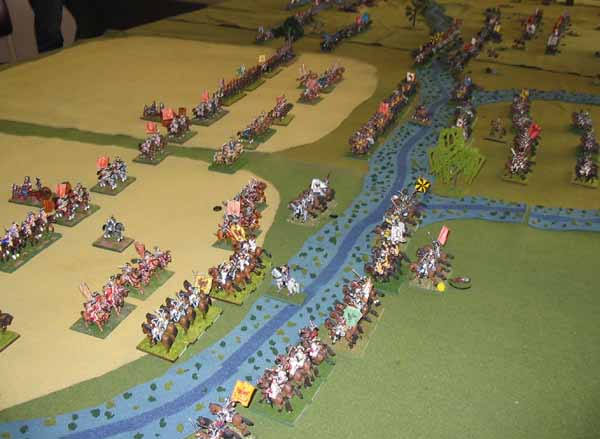 On
the left and right of the Imperial Horse's line, the squadrons were engaged
constantly by attacks and counterattacks at the edge of the cornfields.
Here - the center division can be seen to have pushed back the French squadrons
facing them. On
the left and right of the Imperial Horse's line, the squadrons were engaged
constantly by attacks and counterattacks at the edge of the cornfields.
Here - the center division can be seen to have pushed back the French squadrons
facing them.
Many casualties were taken by both sides
and neither side's division broke, but neither was able to force the other
to give up significant ground.
|
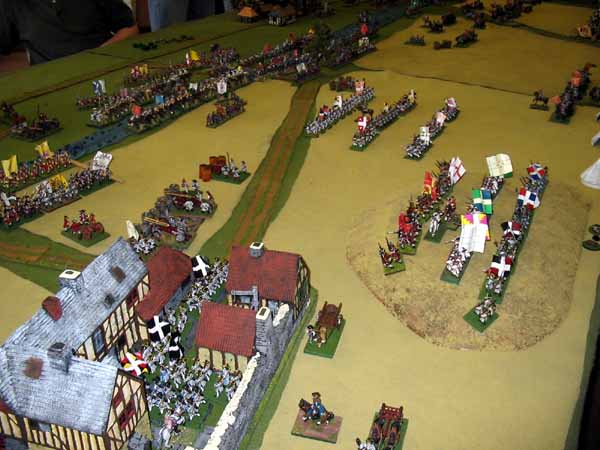 This
is the view in the center after the French cavalry has been pushed back
and broken. It had charged the allied foot that had crossed the Nebel,
but was shot to pieces, and then finished off by the English horse that
had passed through it. This
is the view in the center after the French cavalry has been pushed back
and broken. It had charged the allied foot that had crossed the Nebel,
but was shot to pieces, and then finished off by the English horse that
had passed through it.
However, as can be seen here - the St.
Pierre division of foot, who in reality were subsequently cut to pieces,
here managed to advance and posed quite a threat to the allied horse.
In the foreground can be seen the attack
of Holstein Beck on the the right, and on the left, the Irish Brigade heads
the French Division on the hill.
|
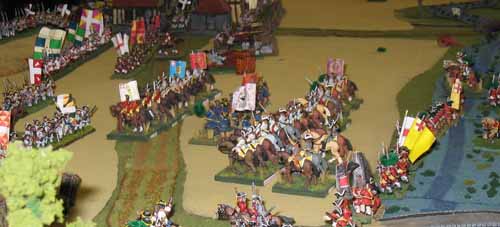 As
St. Pierre's foot reach the allied cavalry that had pushed back the French
cavalry, they are smashed into by chargers from the Danish horse and eventually
driven back to their start position. As
St. Pierre's foot reach the allied cavalry that had pushed back the French
cavalry, they are smashed into by chargers from the Danish horse and eventually
driven back to their start position.
At the same time, the Irish brigade to
their right lead that division off their hill in a counterattack onto to
Holstein Beck's position outside of Oberglauheim.
|
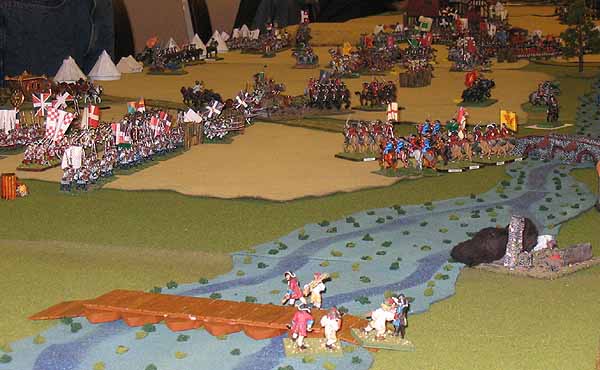 On
the allied right, the attack on Blindheim village does not do enough damage
and the French reserve is not drawn into it's defense as it was in history.
The allied foot that at first crosses the Nebel to screen the cavalry is
pushed back and broken by the French cavalry. The allied cavalry, particularly
the English, then mixes it up with the French Gendarmerie, most of who
are driven back in retreat, but when the French reserve advances to its
support, the allied cavalry is powerless to continue. On
the allied right, the attack on Blindheim village does not do enough damage
and the French reserve is not drawn into it's defense as it was in history.
The allied foot that at first crosses the Nebel to screen the cavalry is
pushed back and broken by the French cavalry. The allied cavalry, particularly
the English, then mixes it up with the French Gendarmerie, most of who
are driven back in retreat, but when the French reserve advances to its
support, the allied cavalry is powerless to continue. |
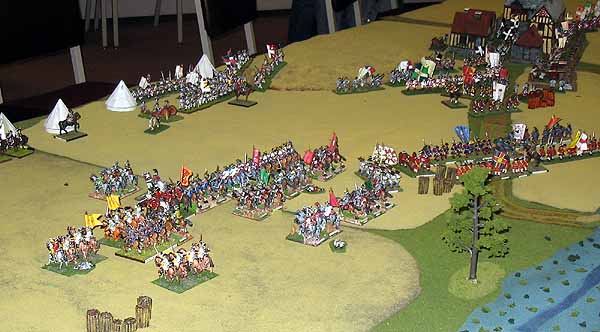 Here
the allied cavalry can be seen t have advanced across the Nebel and solidly
have the center ground, however, they have taken a lot of casualties to
get there, and to their left, significant squadrons of French are still
on the filed. Here
the allied cavalry can be seen t have advanced across the Nebel and solidly
have the center ground, however, they have taken a lot of casualties to
get there, and to their left, significant squadrons of French are still
on the filed.
In the far ground, the Irish can be seen
to have advanced and Holstein Beck's division was beaten back in retreat.
|
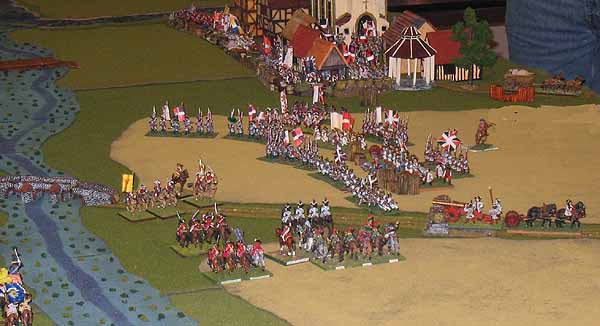 The
attack against Blindheim eventually collapses and the brigades retreat
back across the Nebel severely damaged. To the right of Blindheim, the
entire French reserve, fresh and undamaged, has advanced to the Nebel and
even though the French cavalry to its right is very beat up, the allies
are in no position to contest the ground here. The
attack against Blindheim eventually collapses and the brigades retreat
back across the Nebel severely damaged. To the right of Blindheim, the
entire French reserve, fresh and undamaged, has advanced to the Nebel and
even though the French cavalry to its right is very beat up, the allies
are in no position to contest the ground here.
In order to achieve a victory, the conditions
set were that the allies had to break all of the cavalry on either flank,
i.e. - all of Marsin's or all of Tallard's horse, and also one infantry
division. The French mission was simply to avoid this - which they did
- but only just. The battle was very had fought with nearly 20% casualties
on both side - but a Franco Bavarian victory. |
|
|
|
|
|
|
|
|
|
|
|
|
|
 |
|
|
|
|
Copyright
1997, 1998, 1999, 2000, 2001, 2002, 2003, 2004 Ian Croxall
Salem,
Oregon. USA
SIC
TRANSIT GLORIA MUNDI
|
|
|
|